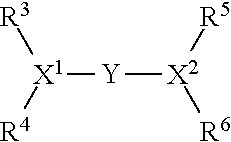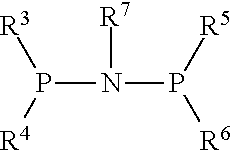Oligomerisation of olefinic compounds in the presence of an activated oligomerisation catalyst
- Summary
- Abstract
- Description
- Claims
- Application Information
AI Technical Summary
Benefits of technology
Problems solved by technology
Method used
Image
Examples
Embodiment Construction
[0219]General catalysis was performed in either a 300 mL volume Autoclave Engineers Reactor equipped with a stainless steel vessel with detachable thermal-fluid jacket or a 1.2 L Premex autoclave with a stainless steel vessel with integral thermal-fluid jacket. Both reactors are equipped with mechanical gas-entraining stirring, and internal cooling coil. Ethylene (Grade 4.5) was supplied by Linde and passed through scrubbing columns prior to use; ethylene flow was measured using a Siemens Sitrans F C Massflo system (Mass 6000-Mass 2100) and the data logged. GC analysis was performed using an Agilent Technologies 6850 Network GC System equipped with PONA column (50 m×0.20 mm×0.50 μm) using hydrogen as carrier gas. All catalytic tests were allowed to run until ethylene uptake had ceased, either due to catalyst deactivation or because the autoclave had filled.
[0220]A mixed chromium (1.25 μmol / mL) / ligand (1.5 μmol / mL) stock solution was prepared in the relevant solvent. The trialkylalum...
PUM
| Property | Measurement | Unit |
|---|---|---|
| Current | aaaaa | aaaaa |
| Current | aaaaa | aaaaa |
| Equivalent mass | aaaaa | aaaaa |
Abstract
Description
Claims
Application Information
 Login to View More
Login to View More - R&D
- Intellectual Property
- Life Sciences
- Materials
- Tech Scout
- Unparalleled Data Quality
- Higher Quality Content
- 60% Fewer Hallucinations
Browse by: Latest US Patents, China's latest patents, Technical Efficacy Thesaurus, Application Domain, Technology Topic, Popular Technical Reports.
© 2025 PatSnap. All rights reserved.Legal|Privacy policy|Modern Slavery Act Transparency Statement|Sitemap|About US| Contact US: help@patsnap.com



